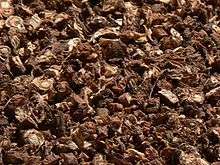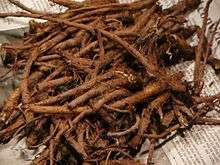Dandelion coffee
Dandelion 'coffee' (also dandelion tea) is herbal tea used as a coffee substitute, made from the root of the dandelion plant. The roasted dandelion root pieces and the beverage have some resemblance to coffee in appearance and taste.
History
Susanna Moodie explained how to prepare dandelion 'coffee' in her memoir of living in Canada, Roughing it in the Bush[1] (1852), where she mentions that she had heard of it from an article published in the 1830s in New York Albion by a certain Dr. Harrison. Dandelion 'coffee' was later mentioned in a Harpers New Monthly Magazine story in 1886.[2] In 1919, dandelion root was noted as a source of cheap 'coffee'.[3] It has also been part of edible plant classes dating back at least to the 1970s.[4]
Harvesting

Harvesting dandelion roots requires differentiating 'true' dandelions (Taraxacum spp.) from other yellow daisy-like flowers such as catsear and hawksbeard. True dandelions have a ground-level rosette of deep-toothed leaves and hollow straw-like stems. Large plants that are 3–4 years old, with taproots approximately 0.5 inch (13 mm) in diameter, are harvested for dandelion coffee. These taproots are similar in appearance to pale carrots.
Preparation
After harvesting, the dandelion roots are dried, chopped, and roasted. They are then ground into granules which are steeped in boiling water to produce dandelion coffee.[5]

Research
As of 2012 dandelion coffee was being researched for a possible role in cancer treatment.[6]
However, in a November 30, 2017 interview, Dr. Caroline Hamm, the oncologist running the study, shared her concerns regarding premature internet hype surrounding these studies. She specifically expressed alarm over individuals contacting her and wanting to risk their health by hastily abandoning standard care. [7]
"It's horrible if someone were to believe this and not take standard of care... And I get emails every week from people around the world thinking they want to stop their standard medicine and take [dandelion tea] instead because of these really unfounded claims. They can die if they do that."
— Dr. Caroline Hamm
Chemistry
Unroasted Taraxacum officinale (among other dandelion species) root contains:
- Taraxacin[8] (a sesquiterpene guaianolide)
- Phenylpropanoid glycosides: dihydroconiferin, syringin, and dihydrosyringin
- Taraxacoside(a cylated gamma-butyrolactone glycoside)
- Lactupircin
- Apigenin-7-glucoside
- Luteolin-7-glucoside
- Isorhamnetin 3-glucoside
- Luteolin-7-diglucoside
- Quercetin-7-glucoside
- Quercetin
- Luteolin
- Rutin
- Chrysoeriol
- Caffeic acid
- Chlorogenic acid
- Chicoric acid (dicaffeoyltartaric acid)
- ρ-hydroxyphenylacetic acids
- Sesquiterpene lactones (of the germacranolide type)
- 11β, 13-dihydrolactucin
- Ixerin D
- Ainslioside taraxinic acid
- β-glucopyranosyl
- Taraxinic acid
- Glucosyl ester
- 11-dihydrotaraxinic acid and 13-dihydrotaraxinic acid
- l'-glucoside
- Lactucopicrin
- Lactucin
- Cichorin
- Eudesmanolides
- Tetrahydroridentin-B
- Taraxacolide-O-β-glucopyranoside
- Prunasin
- Dihydroconiferin
- Syringin
- Dihydrosyringin
- Taraxasterol
- ψ-taraxasterol
- Homo-taraxasterol
- Stigmatsterol
- Cycloartenol
- α-amyrin
- β-amyrin
- Arnidiol
- Faradiol
- Lupeol
- Taraxol
- Taraxaserol and
- 3β-hydroxylup-18-ene-21-one
- Taraxasterol
- ψ-taraxasterol
- Homo-taraxasterol
- β-sitosterol
- Stigmatsterol
- Campesterol
- Other
- Lettucenin A
- Taraxalisin, a serine proteinase
- Amino acids
- Choline
- Mucilage
- Pectin
See also
References
- ↑ Moodie, Susanna. Roughing it in the bush. McClelland and Stewart. p. 385. Retrieved 7 July 2011.
- ↑ Whiting, Julia D. (1886-09-01). "The End of a Love Match". Harpers New Monthly Magazine. Retrieved 2008-12-26.
- ↑ "Much of the surpassing cheap brand coffee is made from dandelion root, according to Prof. William Trelease, of the department of botany at the University of Illinois." Jul 6, 1919 p. V13 Los Angeles Times
- ↑ Edible Wild Plants Class to Feature Dandelion Coffee Jun 16, 1977 p. CS8 Los Angeles Times
- ↑ D’Alessandro, Ruth. "Naturenet: Costa Coffee? Free actually (Instructions for making dandelion coffee)". Naturenet. Naturenet. Retrieved 6 April 2014.
- ↑ "Dandelion tea touted as possible cancer killer" (Pat Jeflyn/CBC Feb 16, 2012 CBC News http://www.cbc.ca/news/canada/windsor/story/2012/02/16/wdr-dandelion-tea-cancer-killer.html
- ↑ http://www.cbc.ca/radio/whitecoat/why-fake-news-is-bad-for-your-health-1.4423628/how-a-canadian-doctor-s-study-on-dandelion-tea-became-fake-news-fodder-1.4427348
- ↑ Ahmad, Viqar Uddin; Yasmeen, Shazia; Ali, Zulfiqar; Khan, Murad Ali; Choudhary, M. Iqbal; Akhtar, Farzana; Miana, Ghulam Abbas; Zahid, Muhammad (2000). "Taraxacin, a New Guaianolide from Taraxacum wallichii". Journal of Natural Products. 63 (7): 1010–1011. doi:10.1021/np990495+. ISSN 0163-3864.

